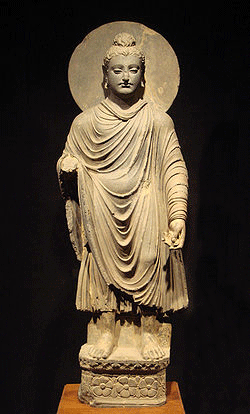 Kathmandu, Nepal — The ancient kingdom of Gandhara stretched across parts of present-day Afghanistan and Pakistan. It denotes the region comprising the modern district of Peshaver and Rawalpindi etc.Anguttara nikaya mentions it as one of the sixteen Mahajanapada.
Kathmandu, Nepal — The ancient kingdom of Gandhara stretched across parts of present-day Afghanistan and Pakistan. It denotes the region comprising the modern district of Peshaver and Rawalpindi etc.Anguttara nikaya mentions it as one of the sixteen Mahajanapada.
The river Indus divided the whole Gandhar region into two parts: eastern and western.Taxila was the main city of Eastern Gandhara and Puskalavati was the3 chief city of western Gandhara.Theentire Gandhara was divided into seven parts:
They were: 1.Taxila, 2.Pusklavati, 3.Nagarahara, 4.Swat valley (Uddyana), 5.Kapisa, 6.Bamiyan, 7. Balkh ( Bamiyan).
For a time, Gandhara also was a jewel of Buddhist civilization. Scholars of Gandhara traveled east to India and China and were influential in the development of early Mahayana Buddhism. The art of Gandhara included the earliest oil paintings known in human history and the first — and some of the most beautiful — depictions of bodhisattvas and the Buddha in human form.
During the 2nd century B.C., it was here that Buddhism was adopted as the state religion which flourished and prevailed here for over 1000 years, starting from 2nd century B.C., until 10th century A.D.
During this time Taxila, Swat and Charsaddah (old Pushkalavati) became three important centers for culture, trade and learning. Hundreds of monasteries and stupas were built together with Greek and Kushan towns such as Sirkap and Sirsukh both in Taxila.
It was from these centers that a unique art of sculpture originated which is known as Gandhara Art all over the world.
The Gandhara art played an important role in the dissemination of the Buddha’s image throughout Asia. It was from Gandhara that Buddhism, at the beginning of Christian era, began triumphal progress across Central Asia to the Far East.
In Gandhara, Buddhist faith and Greek Culture met and intermingled, resulting in the peculiar hybrid art which is called Graeco-Buddhist. It became popular in the regions of Afganistan and Taxila.
The Significance of Gandharan Art
Nearly 2,000 years ago, artists of Gandhara began to sculpt and paint the Buddha in ways that have influenced Buddhist art ever since. Earlier Buddhist art did not depict the Buddha. Instead, he was represented by a symbol or an empty space. But Gandharan artists pictured the Buddha as a human being.
In a style influenced by Greek and Roman art, Gandharan artists sculpted and painted the Buddha in realistic detail.
1. His face was serene.
2. His hands were posed in symbolic gestures.
3. His hair was short, curled and knotted at the top.
4. His robe was gracefully draped and folded.
5. It reveals the impact of Hellenistic influence. Form is strongly
6. Hellenistic while matter is yet Indian.
7. Artistic effects are evidently Buddhistic icons, legends and
8. monuments together with their motifs .
9. Ancient motifs such as atlantes, fantastic creatures, griffons, fauna and flora of India, new motif of vine , acantus, cupids, garlands
10. New elements of hippocampus,triton,marine divinities, gods of Olympus
11. It reveals the impression of the Imperial Roman styles especially thick folded draperies.
12. Another contribution is the figure of Bodhisattva.
13. The artist worked in stone, stucco, terracotta and clay, polychrome and gold.
14. Abundance of images of Hariti, Pancika
15. Seductively beautiful women
16. Highly ornate crowns
17. Masses of jewelry
These conventions spread throughout Asia and are found in depictions of the Buddha to this day.
By Min Bahadur Shakya
Source: www.buddhistchannel.tv




